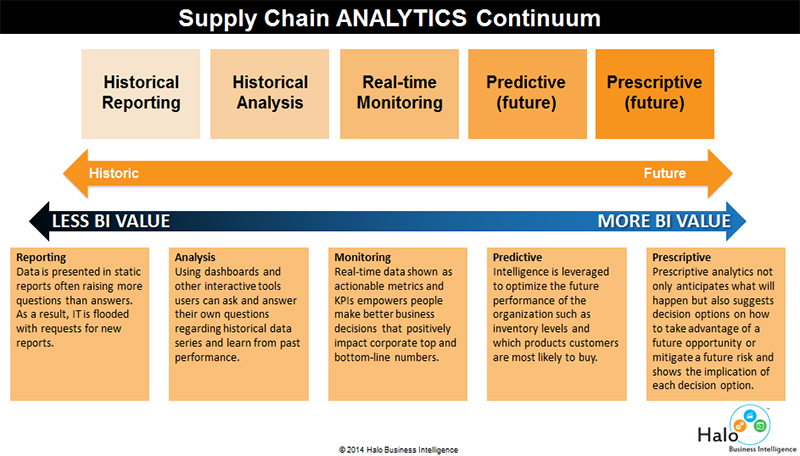One Minute Guide to Understanding the Supply Chain Analytics Continuum
Analytics are now an integral part of any supply chain information management system.
Reporting
The least mature and simplest type of data analytics comes from simply accessing historical data and presenting it as a “report”.
These reports don’t change so they are referred to as “static” reports.
Reporting has been around for centuries and, although simple, it provides valuable data on what has happened in the past.
Adding calculations like percent change allows data to be viewed in ways that helps users understand cause and effect. Static reports also allow the memorialization of data such as those found in financials.
When data is presented in static reports, it often raises more questions than it answers. As a result, IT is flooded with requests for new reports.
Analysis
New tools for data visualization have revolutionized and matured data analysis within the supply chain. “Analysis” in the Business Intelligence vernacular usually refers to the addition of many more mathematical formulas and the ability to visualize the data in different ways, for instance as a bar chart, a map or a graph.
Pivot tables and drill-down capabilities give users insights into data that, just a few years ago, were nearly impossible to achieve. Using dashboards and other interactive tools, users can ask and answer their own questions regarding historical data series and learn from past performance.
Monitoring
More mature supply chain applications make instantaneous decisions based on what they see happening in real time. Machines, weather, transportation fleets, and movement of goods can all be monitored and analyzed in modern business intelligence systems. Companies develop actionable metrics and KPIs empowering people to make better business decisions that positively impact corporate top and bottom-line numbers.
Predictive
The era of predictive analytics has come into its own in. Supply chain and logistics managers can leverage intelligence to optimize the future performance of the organization, such as inventory levels and products that customers are most likely to buy. These types of analytics rely on a series of sophisticated models that run on top of existing historical databases.
In essence, predictive modeling takes historical data and, applying statistical formulas, it determines the relationship between variables in the data set and uses the same relationship to predict what will happen in the future.
Prescriptive
The most mature aspect of analytics today is categorized as prescriptive analytics. This relatively new technology goes beyond descriptive and predictive models by recommending one or more courses of action—and showing the likely outcome of each decision. Prescriptive analytics does not predict one possible future, but rather “multiple futures” based on the decision-maker’s actions. Prescriptive analytics are by far the most sophisticated requiring the most computing power and usually a subject matter expert and data scientist to implement correctly.
Prescriptive analytics work by not only anticipating what will happen but also suggesting decision options on how to take advantage of a future opportunity or mitigate a future risk along with the implication of each decision option.
How mature is your Supply Chain Analytics?
Use the Halo Business Intelligence Maturity Model™ to develop a roadmap that increases the overall effectiveness of your company’s BI implementation and beat the competition through superior insight into your business. Take the Assessment Now!

About the Author
Ray Major is the Chief Strategist of Halo Business Intelligence. A data scientist, economist and statistician by training, he’s a life-long practitioner in the mysterious arts of data intelligence and analytics.
You can contact Ray by email at [email protected] and also follow him on Twitter at @majorbi
Related: Turn Supply Chain Data into Actionable Information














